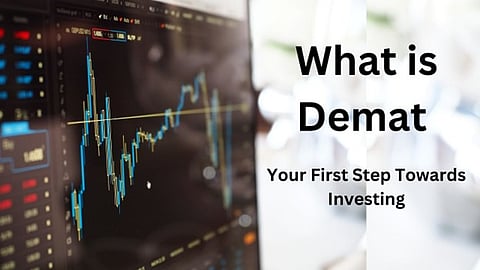A Guide To Opening a Demat Account in India
In today's digital age, investing in the stock market has become more accessible than ever before. One of the fundamental steps in entering the world of stock trading and investing is to open a Demat account. Read on to learn more about the process of opening a Demat account. Also, explore more about what is Demat account, its benefits, and touch upon the concept of a BSDA account.
What is a Demat Account?
A Demat account, short for "Dematerialized account," is an electronic repository for holding and trading financial securities such as stocks, bonds, mutual funds, and Exchange-Traded Funds (ETFs). It offers a secure and convenient way to manage your investments without the need for physical share certificates.
Why Open a Demat Account?
Electronic Storage: A Demat account eliminates the need for physical share certificates, reducing the risk of loss, theft, or damage.
Efficient Trading: You can buy and sell securities seamlessly through your Demat account, making it ideal for active traders.
Safety and Security: Securities held in a Demat account are safeguarded against theft, forgery, and damage.
Investment Diversification: You can invest in a wide range of financial instruments, from stocks to mutual funds, to diversify your portfolio.
Steps to Open a Demat Account in India
Here’s the step-by-step guide to opening a Demat Account offline -
Step 1: Choose a Depository Participant (DP)
The first step is to select a Depository Participant. DPs are entities registered with the Securities and Exchange Board of India (SEBI) that offer Demat services. Popular DPs include NSDL & CDSL among others.
Step 2: Collect Necessary Documents:
Gather the following documents -
Proof of Identity (e.g., Passport, Aadhar card, Voter ID)
Proof of Address (e.g., Passport, Aadhar card, utility bill)
Passport-size photographs
PAN Card (Permanent Account Number)
KYC (Know Your Customer) Form, provided by the DP
Step 3: KYC Verification
Submit your KYC documents to the chosen DP. Many DPs allow online submission for NRIs and resident Indians.
Step 4: Fill Out Account Opening Forms
Complete the Demat and trading account opening forms provided by your DP. Ensure all details are accurate.
Step 5: In-Person Verification
For residents of India, a representative from the DP may visit you for in-person verification. NRIs might need to provide additional documentation.
Step 6: Sign the Document
Review and sign the Demat and trading account agreements, understanding the terms and conditions.
Step 7: Bank Account Linkage
Link your bank account, typically an NRE (Non-Residential External) or NRO (Non-Residential Ordinary) account, to your Demat account for fund transfers.
Step 8: FATCA and FEMA Compliance
Ensure compliance with Foreign Account Tax Compliance Act (FATCA) and Foreign Exchange Management Act (FEMA) regulations, especially if you're an NRI.
Step 9: Account Activation
Once your documents and details are verified, your Demat and trading accounts will be activated.
Here’s the step-by-step guide to opening a Demat Account offline -
Step 1: Visit the official website of the Depository Participant
Step 2: Navigate to the “Open a Demat Account” menu
Step 3: Enter your basic details to navigate to the “Account Opening Form”
Step 4: Enter your personal, nominee and bank account details
Step 5: Upload the necessary documents
Step 6: Complete the e-signature process
Once your request has been processed and verified, you will receive the account details to your registered email.
Basic Services Demat Account (BSDA)
While discussing Demat accounts, it's essential to mention the Basic Services Demat Account (BSDA). This initiative by SEBI aims to make Demat accounts accessible to small investors. Here are some key points to note:
What is BSDA : A Basic Services Demat Account is designed to provide small investors with a cost-effective option for maintaining their holdings. It offers reduced maintenance charges for those with limited trading activity.
Eligibility: Investors with holdings below a certain threshold are eligible for a BSDA. The exact threshold may vary between depository participants.
Benefits: BSDAs come with lower annual maintenance charges, making them an economical choice for small investors. However, they have restrictions on the value of securities that can be held.
Lower Charges: Investors holding a BSDA are entitled to reduced charges for maintaining their Demat accounts, making it cost-effective.
No Annual Maintenance Charge: There is no annual maintenance charge for BSDA accounts if the portfolio value remains within the specified limit.
Regular Account Conversion: If the portfolio value exceeds ₹2 Lakhs, the account will be converted into a regular Demat account, and standard charges will apply.
Conclusion
Opening a Demat account is a fundamental step for anyone looking to venture into the world of stock trading and investments. With the advent of online account opening processes, it has become easier than ever to open a Demat account in just a few minutes.
Remember to choose a reliable Depository Participant or brokerage firm for your Demat account needs. Once your account is set up, you can start building your investment portfolio, trading in stocks, and enjoying the benefits of a paperless and efficient way to manage your securities.
In summary, whether you are a seasoned investor or just starting, a Demat account is your gateway to the exciting world of stock markets, and opening one has never been more straightforward.
Disclaimer: This article is published in association with Bajaj Markets and not created by TNM Editorial.

